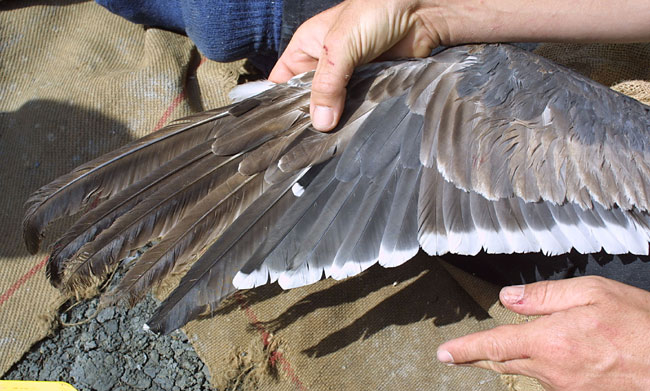 Moult
in graellsii & intermedius
Moult
in graellsii & intermedius
(last update: 10 oktober 2005)
Herring Gull argentatus
Herring Gull argenteus
Herring Gull smithsonianus
Great
Black-backed Gull marinus
Lesser B-b Gull
graellsii / intermedius
Lesser B-b Gull
fuscus
Yellow-legged
Gull michahellis
Yellow-legged
Gull atlantis
Caspian Gull cachinnans
Armenian Gull
armenicus
Baraba Gull barabensis
Heuglini's Gull
heuglini
Vega Gull
vegae
Mongolian Gull
mongolicus
Slaty-backed
Gull
schistisagus
.
Black-headed
Gull ridibundus
Grey-headed
Gull cirrocephalus
Brown-headed Gull
brunnicephalus
Bonaparte's
Gull philadelphia
Little Gull minutus
Mediterranean
Gull melanocephalus
Relict Gull relictus
Audouin's Gull audouinii
Slender-billed
Gull genei
Common / Mew
Gull canus
Ring-billed
Gull delawarensis
Franklin's Gull
pipixcan
Laughing Gull atricilla
Kittiwake Rissa
tridactyla
Ivory Gull Pagophila
eburnea
Ross's Gull Rodosthetia
rosea
Sabine's
Gull sabini
Great
Black-headed Gull ichtyaetus
Sooty Gull hemprichii
White-eyed Gull leucophthalmus
Glaucous
Gull hyperboreus
Iceland Gull glaucoides
Thayer's Gull thayeri
Kumlien's
Gull kumlieni
.
Mystery Gulls
Skua's Catharacta
/ Stercorarius
Terns Sterna
Other
Birds & Mammals
.
Home
Links
to Gullsites
Gull taxa
Gull Topography
Grey & Colour Charts
Locations in NW Europe
Summaries of Articles
About ORG
@
| Suspended
& arrested moult in adult graellsii in summer. (back
to the index)
The article of Lars Jonsson in BW 11-8 (1998) gives excellent insight in the features and moult strategy of Baltic fuscus. Without doubt, it's still the best article written about nominate fuscus and it's ID and many bird-watcher look closer at local gull flocks since. In his article, Jonsson mentions some features and plumages which (when combined) should highly advocate fuscus over intermedius and graellsii. However, it remains to be seen whether the points he mentions fully exclude intermedius. Except for upper-part colouration and jizz, arrested moult is such a feature worth looking for. As stated in his article and in the Discusfus Section at this site, arrested moult may be a common feature in nominate LBBG fuscus from Sweden and Finland, particularly in immature birds. However, this phenomenon may be overlooked in most graellsii and intermedius LBBG. First field research in the Netherlands estimates arrested moult to occur in about 4% in (predominantly immature) graellsii and particularly intermedius LBBG. This figure is based on a very rough count of "only obvious" suspended moult in resting LBBG in 2001. Nevertheless, the existence of arrested moult on such a scale makes it more difficult to fully exclude intermedius once one come across an immature dark, gentle bird with arrested moult in a resting group of LBBG in Western Europe in May or June. One should always consider the possibility of intermedius combining the features of arrested moult, gentle, elongated structure and dark fresh coverts and scapulars. But what about dark adults in autumn? In the Discusfus Section, it's mentioned that quite some adult LBBG from Western Europe may leave the colony without moulting a single primary. They originate from local Dutch colonies in the Netherlands and we believe some of them to be intermedius (not fuscus); see the tables in the sections Adults in August and Adults in September). Old primaries may still be present in the first half of September, but is nevertheless very unusual. This will give a late completion date of primary moult into late March. To find support for this thesis is very difficult and it is hard to prove, simply by the fact you won't find these adults with suspended moult anymore in NW Europe; they move on quickly. Research should be done at the first stop-over sites along the Atlantic coast or further south.
But one thing is
certain: the primary moult strategy for adult Dutch intergrades LBBG in the Netherlands, graellsii LBBG from Britain and
probably intermedius LBBG from W Scandinavia is
highly variable. This can be seen in returning birds in spring and
breeding birds in the colony. On this page, we like
to show photographs of graellsii LBBG with suspended primary
moult in the inner-hand in summer. Peter Stewart comments: "on your page showing a probable fuscus in NW France May 2001. You have written that arrested moult is a rare phenomenon in both graellsii and intermedius. This is incorrect. It is quite normal, and here in the UK suspended moult is obvious in many adult birds we catch, mainly from June to July. These birds replace only a single primary at a time and can be found with up to suspended P3. Many other birds caught during the same period are about to suspend or resuming moult after suspension by dropping the next primary. We have also found adults birds in April with suspended P1, and these birds are obviously commencing primary moult and suspending in winter quarters, as we have yet to find a bird that has started primary moult in February and March in the UK. Suspended moult, especially involving inner primaries, is not obvious in the field and easily overlooked, especially on birds that show little wear on old primaries. Most earlier researchers have overlooked suspended moult, hence the belief that some birds have yet to start their primary moult, and provide later starting dates for the onset of moult. I have some 4500 moult scores for adults, and recorded 183 different primary moult patterns for adults, with a total of 201 different patterns for all age groups. Sick and injured birds in captivity, can also behave differently and can also suspend at odd times." In
the near future we are happy to show more footage and research
results and we try to find a way to extend this research to other
places and LBBG colonies. Peter Stewart comments on the tables
presented in the Adults in
September: the latest dates for 10 old primaries in
my study is in the first half of August and involves two birds only.
My samples involve several hundreds of birds in the hand. All
old primaries present in the first half of September, surely is very
unusual.
|
||||||||||||||||||||||||||||||||||||||||||||||||||||||||||||||||||||||||||||||||||||||||||||||||||||||||||||||||||||||||||||||||||||||||||||||||||||||||||||||||||||||||||||||||||||||
|
Here,
a photograph of a graellsii with suspended P1-P3. This was
taken on the 18 June. Peter Stewart has eight birds on his database
showing this pattern between the 16 June and 8 July. Seven of the
birds are adult and the eighth bird is a 3rd summer. |
 |
|||||||||||||||||||||||||||||||||||||||||||||||||||||||||||||||||||||||||||||||||||||||||||||||||||||||||||||||||||||||||||||||||||||||||||||||||||||||||||||||||||||||||||||||||||||
|
Here is a bird with suspended moult in p1&p2. |
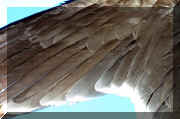 |
|||||||||||||||||||||||||||||||||||||||||||||||||||||||||||||||||||||||||||||||||||||||||||||||||||||||||||||||||||||||||||||||||||||||||||||||||||||||||||||||||||||||||||||||||||||
|
Here
is one of the odd moulting birds Peter came across. This bird was
brought in sick to a local wildlife sanctuary in November 2001. This
bird had suspended p1 to p5, and in both wings p5 shows obvious
fault bars. |
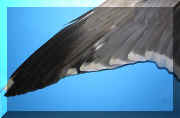 |
|||||||||||||||||||||||||||||||||||||||||||||||||||||||||||||||||||||||||||||||||||||||||||||||||||||||||||||||||||||||||||||||||||||||||||||||||||||||||||||||||||||||||||||||||||||
|
Here is a bird with suspended p1. This would not be obvious the field and easily overlooked in the hand, especially if the other primaries show little wear. We have undoubtedly overlooked birds with suspended p1 in April in the past, when this image was taken. Peter says: "We now look closely at all birds at all times of the year." |
 |
|||||||||||||||||||||||||||||||||||||||||||||||||||||||||||||||||||||||||||||||||||||||||||||||||||||||||||||||||||||||||||||||||||||||||||||||||||||||||||||||||||||||||||||||||||||
|
This image was taken in January 2001. This bird had obviously undergone some sort of stress during the breeding season. Peter: "We caught a large number of graellsii during January 2001, many showing fault baring in the primaries, but not so extreme as in this sample. Either there was a shortage of food near breeding grounds, or possibly sickness (botulism) may have been responsible. There was much botulism around in the previous year, and some birds do survive the effects. But most perish." |
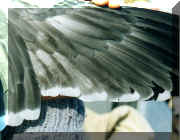 |
|||||||||||||||||||||||||||||||||||||||||||||||||||||||||||||||||||||||||||||||||||||||||||||||||||||||||||||||||||||||||||||||||||||||||||||||||||||||||||||||||||||||||||||||||||||
|
Undoubtedly, some
overlap exists between the primary moult in fuscus and intermedius.
Peter catches many LBBG in Britain and comments on his picture:
"This photograph is of a very dark individual we trapped on the
17 August 2000. The bird has just dropped P1-P3, thus if seen in the
field would undoubtedly been claimed as nominate fuscus. To
me this bird had recently arrived on passage and commenced its
primary moult. We have only one record of an adult graellsii
exhibiting this same score and pattern in August. Usually it is only
immature birds which exhibit this pattern and only
during late May - June. It would be nice
to hear from Scandinavian birders the evidence for the above
phenomenon. It would also be nice to know whether the evidence
for this statement was based on trapped and ringed individuals. Peter continues:
"Suspended moult mainly involves adult birds and during the
breeding season. It is not common in immature birds. We have
found resumption of moult after suspension in only three second
summer birds, and both suspended and resumption of primary moult in
seven third summer birds. No first summer birds have been found
in suspended moult. Suspended moult therefore appears to be mainly
associated with breeding birds. |
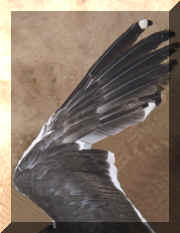 |
|||||||||||||||||||||||||||||||||||||||||||||||||||||||||||||||||||||||||||||||||||||||||||||||||||||||||||||||||||||||||||||||||||||||||||||||||||||||||||||||||||||||||||||||||||||
|
Peter comments: "The photograph shows how our 2nd-summer bird would appear prior to primary moult. This photograph was taken in January when our BTO age code changes from 5 to 7, progressing from 2nd-winter to 2nd-summer." |
 |
|||||||||||||||||||||||||||||||||||||||||||||||||||||||||||||||||||||||||||||||||||||||||||||||||||||||||||||||||||||||||||||||||||||||||||||||||||||||||||||||||||||||||||||||||||||
|
Peter writes: Regarding the Lesser
Black-backed Gull - this has been the main study species of the
Severn Estuary Gull Group since 1986. And since that time we have
ringed some 12900 birds. We currently ring 76% of all the free
flying Lessers in the UK. Most of our ringing is done with metal
BTO rings, though we have used colour on chicks and adults, as is
show on the cr-birding website. All of our ringing is done at
landfill sites, mainly in Gloucestershire. The Hempsted Gloucester
site is probably the most important landfill sites in the UK for
both wintering gulls and passage migrants. There are some 500+
pairs of Lessers breeding locally to this site. Also the nearby
Severn Estuary probably holds the largest number of roosting gulls
in winter, 300,000+. There were some 10,000 mixed gulls on
Gloucester landfill site by November, with many thousands
also visiting other landfill sites in our study area.
I personally have been interested in
gulls for many years, since 1976, and have several large databases
of recoveries for Lessers, (including the BTO database up to
1996). I have produced reports and bulletins on our work, and have
just completed a paper on Lesser Black-backed Gull primary
moult. This has taken me 8 years to put together, and
covers four different age groups. I have also added a little
on intermedius primary moult to make it a little more
interesting. I also have lots of interesting photographs,
especially of intermedius, and currently putting together
an album of photographs showing the various plumages of age
groups, for ageing when ringing. These are close ups of
individual groups of feathers. I have found the secondaries a
useful aid to ageing, but one needs to have birds in the
hand, or dead specimens, to look at these closely. Despite
all my years study I find that all is not straightforward, there
is much individual variation. I find every one of our catches
interesting. I use a Canon D30 digital camera along with a
collection of various lenses. It is a superb machine, and works
well along with my Canon 5 film camera.
I use DMAP and can produce maps very
quickly from my databases. I produced our last progress report in
1996. This gives a summary of all our ringing activities over the
period 1986-1996. I have written much on the Lesser in this report
and have given details of all roosting sites (with numbers),
breeding sites, and landfill sites, not just for our study area
but for the whole of the West Midlands area of the UK. I have also
given tables of sightings of 3,292 colour ringed birds in our
study area.
To contact Peter: Peter Stewart. |
||||||||||||||||||||||||||||||||||||||||||||||||||||||||||||||||||||||||||||||||||||||||||||||||||||||||||||||||||||||||||||||||||||||||||||||||||||||||||||||||||||||||||||||||||||||
|
||||||||||||||||||||||||||||||||||||||||||||||||||||||||||||||||||||||||||||||||||||||||||||||||||||||||||||||||||||||||||||||||||||||||||||||||||||||||||||||||||||||||||||||||||||||
